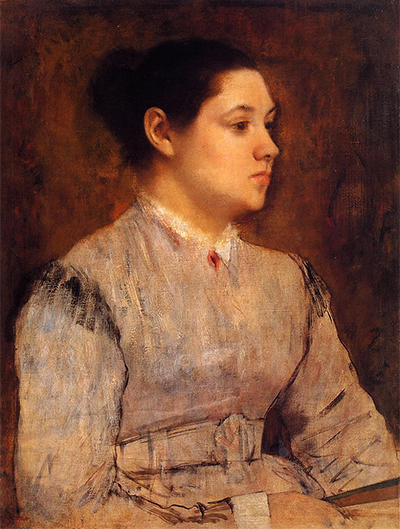Upon the artist's journey across Italy to study a new form of art, Degas encountered a religious experience that is believed by art critics and historians to be the influence behind the painting, Portrait of a Young Woman. Similar styled artwork to the alluring painting are by the artist's contemporaries Pierre-Auguste Renoir and Claude Monet.
Edgar Degas had travelled through the lush plains of Italy and encountered a religious revolution internally. The artist met three men who went to Arezzo, where Degas decided to accompany them. Upon communicating with the pastors at the church; Degas felt that he understood a greater deal about himself. This conversation allowed Degas to experience self-doubt as a man within society. The artist felt as if he understood where his future laid in terms of his relationship with women, and was inspired to create a piece that showcase this deep emotion he felt. This life changing event had inspired Degas to produce Portrait of a Young Women; a painting that showcases the type of woman the artist desired, yet questioned if he could attain. (There is more on this in our Edgar Degas biography).
Edgar Degas had produced this piece in his early twenties, a moment within his life of uncertainty in his own character as he questioned whether woman would find love within him. The young woman within the portrait evidently showcases the deep emotion Degas felt as he questioned whether he could attain someone in this form. The Portrait of a Young Woman is meant to showcase all the desirable features Degas hoped for. Her rounded face holds the classic French female characteristics present in the artist's other pieces, bringing the viewers' attention to her rounded face and small pointy nose. Her face is turned to a side profile as a light contour graces the side of her face, while still highlighting the excess weight beneath her face. Her eyes are lightly showcases in a deep hue of brown, fixtured on an object in the distance.
The young girl's hair is blurred in black as it mixes in with the background of the painting as Degas embraces his Baroque style. The background behind the woman is an array of deep burgundies and browns splashed together with hints of dark shades. The wavy brushstrokes upon the background of the canvas adds a rough sense to the artwork, as Degas pays tribute to the innovative times of France turning away from the classic style before his time. While the painterly Baroque style was prominent until the 19th century, it is evident that Degas remained fixated on showcasing his art through a subjective style rather than a rational point of view. Degas uses an array of brush strokes to showcase the material of the young woman's dress, zigzagging all over the canvas. These hues of blue and grey bleed into one another forming a light teal blue that holds as the basis of the colour scheme.
It is brilliant to recognize the characteristic in which way Degas paints the ruffled lace collar around her neck. Veering incredibly away from the realist classical painting technique of the 16th century, Degas uses an experimental approach through only showcasing a glimpse of the white ruffled collar. Yet, the brilliance behind his work is that the viewer is still able to recognize the structure of the collar and piece it together. Degas understood the optical approach the human eye held through its ability to piece different elements of art to form a rational understanding. Degas continues this strategy as he paints the belt of the woman’s dress, only through a few linear black lines to create the structure of the belt. It is the viewer who brings these lines together within their own mind to figure out their exact meaning. The artist had mastered both a highly detailed approach towards showcasing the muse, alongside a creative Baroque style that leaves the viewer pondering the work.




